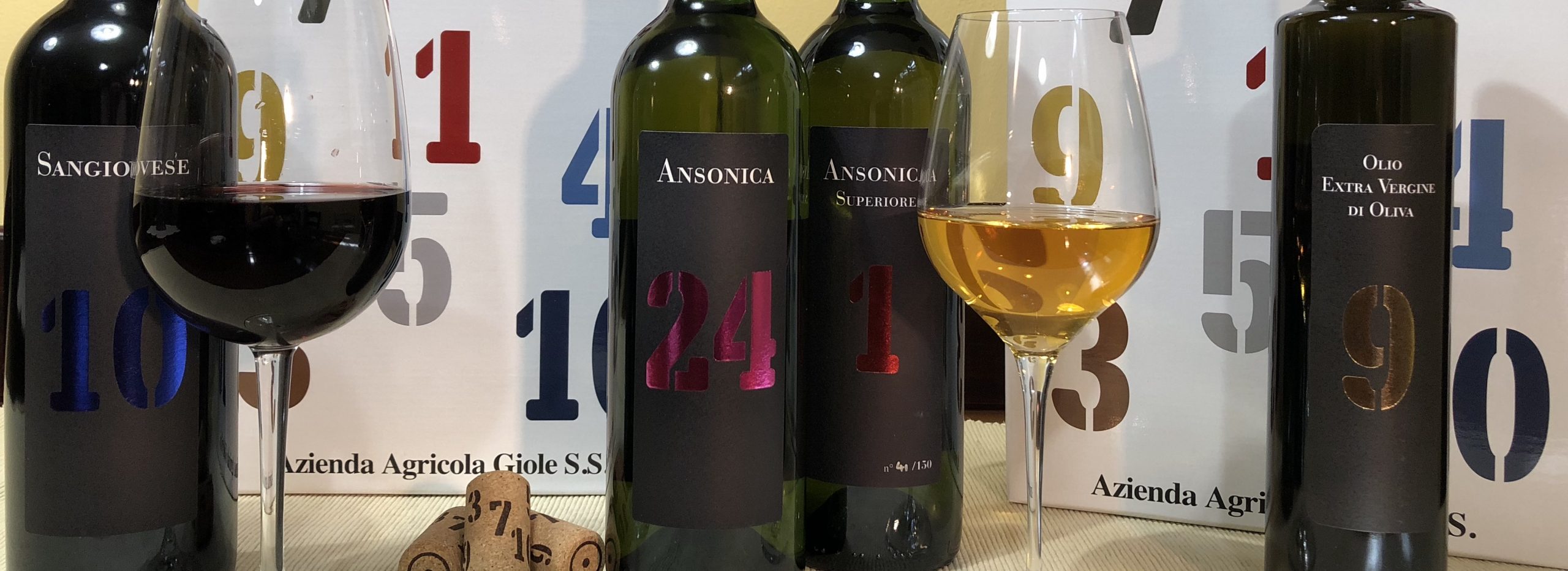
Our products
An ancient farm on the Monte Argentario promontory in front of the Giglio Island, a small plot of land where, more than one hundred years ago, hardworking hands created vertical terraces overlooking the sea and started an Ansonica vineyard: this is the paradise where our grapes flourish.
The grapes, turned golden by the sun and caressed by the wind, are made from a single grape variety.
Vine varieties
100% Ansonica
Production area
Monte Argentario promontory
Vineyard characteristics
These centennial vines are grown on mainly sandy soil, using the Tuscan “capovolto,” or arched-cane, system. The vines are not very productive on their own, yielding no more than 1.5 kilograms of grapes per plant.
Agronomic techniques
All the work in the vineyard is done by hand; mechanical devices are not used in this small area of natural beauty, nor are any synthetic products; diseases are kept under control only with copper and sulfur treatments. The grape harvest usually takes place in the last week of September, when the grapes have turned golden, thereby reaching their optimum ripeness.
Winemaking
Because these grapes are so unique, winemaking must be a traditional process: spontaneous fermentation on the skins for 15 days without temperature control; pressing and aging in concrete tanks, on fine lees, for six months. Racking and bottling without filtration.
Organoleptic notes
Bright golden yellow color. Our sense of smell picks up some fruity notes, even exotic ones, and candied citrus fruit. Beeswax and iodized aromas merge with those of yellow flowers and medicinal herbs. The wine tastes sapid. Its tannic presence is strong and derives from the long maceration process. The persistence is good up until the final notes of dried sweet fruit and fruit preserved in alcohol.
Recommended pairings
Fish stews, such as the traditional “caciucco” associated with the Tuscan city of Livorno, and “vitello tonnato” (a traditional Piedmontese dish of cold, sliced veal covered with a creamy sauce flavored with tuna).
Serving temperature
14° C
€24,00


IGT Toscana Vermentino – 3
This grape variety has ancient origins and has always been grown in Tuscany. The aroma of its wine reminds us of days spent relaxing on the beach with a lovely breeze.
Vine varieties
100% Vermentino
Production area
The municipality of Marciano (province of Grosseto)
Vineyard characteristics
These young vines are grown in sandy-clay soil of fluvial origin enriched by the presence of pebbles usually found on riverbeds.
Agronomic techniques
We don’t use any synthetic products; disease management consists only of copper and sulfur treatments. The grape harvest usually takes place in the first week of September, when the grapes have reached optimum maturity and have turned chestnut brown, the typical color of mature Vermentino.
Winemaking
Static clarification at 8° C without any additives; white fermentation at the controlled temperature of 19° C; the wine ages on its fine fees for three months and is bottled in the beginning of spring.
Organoleptic notes
Bright golden yellow color. The nose is immediately and pleasantly reminded of white flowers and fruit. Grassy and almond-like notes complete the aromatic bouquet. The wine tastes sapid and is well-structured. Each sip proves that it is balanced in all its components; its long persistence makes it enjoyable in any situation.
Recommended pairings
Fish appetizers, soups, vegetables.
Serving temperature
12° C
€14,00
IGT Toscana Sangiovese Badia a Ruoti – 4
In Badia a Ruoti, in the province of the city of Arezzo, for the past four generations the Cortesi family has owned a small plot of land where the vines that produce this wine, in very limited quantities, have grown for more than eighty years.
Vine varieties
90% Sangiovese, 10% Canaiolo and Colorino
Production area
The municipality of Badia a Ruoti (province of Arezzo)
Vineyard characteristics
Altitude of 300 meters above sea level, soil with a calcareous clay composition; this is where the ancient vines are grown with the Tuscan “doppio capovolto,” that is, double-arched cane system.
Agronomic techniques
Our natural farming methods are environmentally friendly: fertilizations are carried out with organic material, and diseases are kept under control only with copper and sulfur treatments. The grape harvest, done by hand, takes place in the first ten days of October. Each vine yields about three kilograms of grapes.
Winemaking
Spontaneous fermentation with indigenous yeasts at the temperature of 26° C; contact with the skins for 20 days. The wine ages on its own thin lees for six months in third passage tonneaux (barrels). It is decanted and bottled in the late spring, the year after the harvest.
Organoleptic notes
Bright ruby red with delicate garnet reflections. The nose is immediately greeted with black cherry aromas, associated with notes of underbrush and black spices. The mouth is fresh and sapid; the subtle tannin remains in the mouth up until the pleasantly bitter and dry finish.
Recommended pairings
First courses with meat, main courses with game, cured meats, aged cheese.
Serving temperature
16° C
€24,00


IGT Toscana Sangiovese – 10
This Sangiovese vineyard is located in one of the most inland and hilly areas of the Maremma near Grosseto. Here the Sangiovese wine of the Cortesi family is transformed into a fresher, fruitier and ready-to-drink version.
Vine varieties
100% Sangiovese
Production area
The municipality of Manciano (province of Grosseto)
Vineyard characteristics
Altitude of 200 meters above sea level, skeletal soil with a clay composition. The 15-year-old vines are cultivated with the spurred cordon system.
Agronomic techniques
Our farming methods are based on natural, environmentally friendly processes: we use only organic fertilizers, and disease management consists only of copper and sulfur treatments. We harvest the grapes by hand in the last ten days of September. Each vine yields about two kilograms of grapes.
Winemaking
Spontaneous fermentation with indigenous yeasts at the temperature of 26° C; the grapes remain on the skins for 15 days. The wine ages on its fine lees in concrete tanks for six months. It is decanted and bottled in the late spring, the year after the harvest.
Organoleptic notes
Bright ruby red with slight garnet reflections. The nose is greeted with notes of cherry, wild strawberry, followed by citrus and Oriental spice aromas. In the mouth, it is balanced by a fine-grained tannin and flowery and fruity aromas. It is full-flavored but also quite sharp.
Recommended pairings
First courses served with meat sauces, grilled and oven-roasted red meat, medium-aged cheese.
Serving temperature
16° C
€14,00
IGT Toscana Ansonica – 24
The grapes used to produce the ANSONICA 24 wine come from an ancient vineyard located on the stunning coastline of the Maremma, near Grosseto in Tuscany, where the sky, sea, and earth come together, offering a breathtakingly beautiful panorama.
Vine variety
100% Ansonica
Production area
Parrina (Orbetello)
Vineyard characteristics
The soil is mostly sandy, with some clay and loam. We use the Guyot pruning and training system in the vineyard.
Agronomic techniques
Our farming methods are based on natural processes and on our respect for the vines and for the environment in which they grow: we use only organic fertilizers, and disease management consists only of copper and sulfur treatments. The grape harvest takes place in the second decade of September. Each vine yields about three kilograms of grapes.
Winemaking
10% of the grapes are left on the vines to ferment spontaneously for one week; these are used as a “pied de cuve” to activate the alcohol fermentation process for the rest of the grapes, turning them into white wine at the controlled temperature of 19° C.
The wine is then aged in stainless steel tanks, on fine lees, for three months. It is decanted and bottled in the spring following the harvest.
Organoleptic notes
Intense yellow, similar to the color of straw, and well-structured. With delicate and elegant aromas, this wine is characterized by notes of yellow fruit, quince and citrus fruit, accompanied by herbal, white flower, and mineral hues. The smooth feeling in the mouth immediately gives way to a lively citrus acidity sustained by sapidity; the good persistence is reminiscent of vegetal notes.
Recommended pairings
Cocktails and appetizers, goat cheese, white meats or fish main courses, even accompanied by sauces.
Serving temperature
12° C
€14,00


Olive Oil Extra – 9
Our olive grove grows on hilly areas where the rocky terrain confers excellent olfactory and visual characteristics to the final product, guaranteeing a particularly low acidity.
The trees are about 30/40 years old. Indeed, in some plots of land, they are more than 90/100 years old.
The trees are planted in irregular rows, often scattered over large areas, which allows them to have enough space, thus preventing the need for antiparasitic treatments. This gives a huge advantage to the oil, especially in terms of its slightly bitter taste. The color of the olives is green with golden highlights, and their aroma is fruity and slightly spicy, which enhances the flavors of fine Mediterranean cuisine.
The harvest is done exclusively by hand, and the pressing of the olives takes place within a few hours to prevent the formation of high levels of acidity.
The olive grove covers three terraced hectares in the southwestern and northwestern areas of the farm, where cultivars have been recently introduced to provide support to the ancient trees that have been there since the early twentieth century.
Our completely integrated production chain allows for working time to be reduced and for there to be an optimum control over the entire production cycle. Our basic production is reserved for the family; the Italian and foreign markets do not receive more than 20% of the entire harvest.
Cultivar Leccino
Frantoiano
Moraiolo
Pendolino
Cultivation system
Goblet-trained.
Cultivation form
Globe.
Planting year
1920 and 2000.
Soil
Clayey – calcareous of medium consistency.
Slope, 200 meters ASL.
Southwestern and northwestern exposure.
Variable production, 15 quintals per year on average.
Harvest period
First fifteen days of October.
Harvest
Hand picking.
Extraction system
Continuous cycle.
Pressing of the olives
Within six hours from the harvest.
Conservation
In stainless steel containers.
Organoleptic characteristics
Excellent with locally caught fish, boiled shrimp and prawns, salt-crusted sea bass, or just with vegetables. This oil adds a delicate flavor to mayonnaise used in a cocktail sauce. It is also ideal for more strongly flavored and structured dishes, such as wild boar stew.
€12,00
